Drying Flowers: How to Preserve The Beauty of Your Cutting Garden
CraftsFresh flowers are lovely, but they don't stay fresh forever. Dried flowers are a great alternative! They don't need to be watered, and they will never wilt on you. Preserving allows you to enjoy the beauty of your garden year-round!

Methods for Drying Cut Flowers
There are many methods for preserving fresh flowers from your garden, so let's look at a few of the ways to dry flowers for floral arrangements and crafts.
Hanging Flowers to Air Dry
Air drying has been used for centuries and is the most common and easiest method to dry flowers. Choose blooms at their peak to get the best results when air drying. Look over the flowers and choose the most beautiful blooms. Ragged or bug-eaten petals will look even worse once they have dried.
Cut fresh flowers in the morning when they are fully hydrated and not wilting. Strip excess foliage and gather flowers into small bundles where they will have enough airflow between flower heads. You can hang individual stems, but when drying many flowers at a time, it is easier to put them together in bundles.

Hang flowers in a dry space that is out of direct sunlight. Good airflow and low humidity will result in a shorter drying time. It can take three to five weeks for flowers to fully dry, depending on the temperature, humidity, and the type of flower.
Some flowers that dry well with the air method are strawflowers, paper daisies, hyssop, yarrow, larkspur, and lavender. Seedpods also dry well and add to the color and dimension of dried flower arrangements. Milkweed and poppies are two varieties that produce beautiful seedpods.
Some ways to use air-dried flowers are in wreaths, vase displays, arrangements in vases or glass jars, swags, boutonnieres, corsages, and resin jewelry.
Dried flowers are perfect for crafting. Make lush wreaths for your front door, pressed flower artwork, or a little nosegay for a wrapped gift.
Pressing Flowers to Dry
As long as there have been books, there have been pressed flowers. Pressing flowers to dry is a simple method of preserving flowers and gives you beautiful specimens to be used in all kinds of crafts. While you can always just place a blossom or leaf in the pages of a favorite book, with a little more planning, you can select blooms to create lovely works of art and other crafts.
A watercolor notebook works well if you don’t have a flower press. Place flowers directly on the pages while leaving a few pages between flowers. Next, place a heavy object, such as a brick or a really heavy book, on top of the notebook. If you are pressing flowers in a book, use blotting or watercolor paper, so the petals do not bleed onto the pages of your book and make removal easier. Pressing flowers too hard can make them stick and make them harder to remove from the paper.
Cut fresh flowers from your garden when they are at their prime, being careful to choose greenery and flowers that are free of blemishes. Some flowers that dry well with pressing are cosmos, columbine, sweet pea, borage, violas, forget-me-not, larkspur, poppies, and zinnias.
Pressed flowers can be used in all kinds of artwork, jewelry, and stationery crafts, such as cards and bookmarks.

Drying Flowers With a Microwave
If you’re looking for a quick alternative to air-drying, try the microwave method of drying flowers. Lay flowers on a sheet of folded paper. Next, place a paper towel on top of the flowers and fold your paper over the top. Place any microwaveable heavy object on top of the paper and flowers. Microwave in 30-second intervals and then check the flowers. It may take 30-90 seconds for your flowers to dry completely. You will know when the flowers are done because they will be completely dry and not tacky or sticking to your fingers. If they aren’t quite done when you touch them, just microwave them for another 30 seconds.
Try paper daisies, hyssop, yarrow, larkspur, and poppies with this method. Avoid white flowers as they may discolor with the microwave method.
Drying Flowers with Silica Gel
Silica gel is a relatively modern way of preserving flowers. Drying flowers with silica gel gives petals a papery texture in the finished product. It also works better with sturdier flowers that can withstand the weight of the powder.
When using silica gel, it is important to wear a dust mask as the dust is harmful to your lungs. Place the flowers in a container where you can cover all the parts of the flowers. Then cover with a lid. It will take three to five days for the flowers to dry completely. When they are dry, you can use a small, soft paintbrush to remove the dust.
Snapdragons, sunflowers, zinnias, carnations, and daisies are some varieties of flowers to dry with silica gel.
Silica is a great method to use when you want to preserve the natural color and shape of flowers, such as when making wreaths and floral arrangements.

Drying Cut Flowers in a Food Dehydrator
With low heat and consistent airflow, a food dehydrator can be a good choice for drying flowers. This controlled environment will allow you to dry flowers faster, especially in more humid climates.
Some flowers to try in a dehydrator are marigolds, carnations, coneflowers, and yarrow.


Selecting Flowers for Drying
There are some general guidelines to remember when you grow your own flowers for drying.
- When planting your own cut flower garden, plant more than you think you need. Also, pick more than you think you will need. Flowers and stems shrink when they dry, and not all flowers will dry exactly the way you want them to. This means you will need to start with more to end up with enough for your finished project.
- When you pick flowers for drying, pick them during their prime blooming time. Carefully look over the leaves and petals and select the best blooms. Any spots, insect damage, or torn petals will be even more evident when dried.
- Once dried, keep flowers away from sun and moisture. Sunlight will continue to fade them after they are dry, so keep them out of direct light.
- To keep dried flowers clean, you can blow off the dust with a hairdryer to keep them looking their best.
Drying flowers is an easy way to preserve the beauty of your flower garden. With these simple methods, you can enjoy the colors of your garden throughout all seasons of the year.
Popular Posts
-

Hollyhocks from Seed: The Perfect Addition to Your Cottage Garden
-

How to Prevent Squash Vine Borers Before It's Too Late







Leave a comment